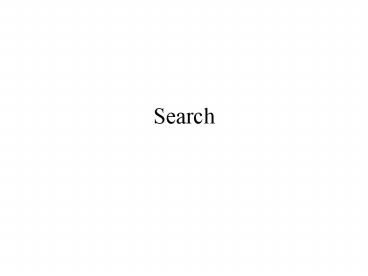Search PowerPoint PPT Presentation
1 / 19
Title: Search
1
Search
2
Search and Economics
- Search is ubiquitous
- Money as a search efficiency
- Eliminates double coincidence of wants in search
for barter exchange - Job search
- Matching of individual abilities with firm labor
needs - Product search and shopping
- Price dispersion and location
- Research and development as a search activity
- Proprietary versus open source
3
Search Costs
- Sequential search
- At each step of the search process, the consumer
incurs an additional search cost (general in
terms of disutility of time spent searching) - Given this cost, consumer must decide whether to
purchase at the price quoted by the store, or
whether to continue searching, incurring the
search cost
Store 1
Store 2
Purchase
Purchase
No
Info Gathering
Info Gathering
Yes
Yes
4
Search Costs
- Example
- Alice faces search costs of 1 to travel to each
store - At store 1, Alice is quoted the price of 10 for
a blouse - If she purchases from store 1, her total cost
(including the search cost) is 11 - Suppose Alice decides not to purchase and instead
goes to store 2. - At store 2, she is quoted a price of 9.50 for
the same blouse - If she purchases the blouse here, her total cost
will be 11.50 (since she incurs total search
costs of 2 -- 1 to visit the first store and 1
to visit the second store).
5
Search Costs
- Issue of repeated versus one-time purchases
- Market with continual inflow of new, uninformed
buyers, will lead to prices at the monopoly level - Market in which buyers visit firms repeatedly
lead to reduced search costs as buyers learn
about individual stores pricing practices - Explains why prices at tourist traps are
significantly higher than in markets which serve
regular customers - Location issues
- In a linear market, stores near the parking lot
can charge higher prices by virtue of their
location
6
Search Costs
- Simultaneous search
Store 1
Info Gathering
Purchasing
Store 2
No
Store 3
Yes
Store 4
7
Search Costs
- Simultaneous search involves collecting
information from a number of different sources at
one time, and then evaluating this information
simultaneously. - Parallel evaluation
- Example Open-source software development as a
search and discovery process - Costs of simultaneous search stem from the need
to organize the evaluation process to make
comparisons of complex information - Related cost of determining what to deliver when
a simultaneous search is requested
8
Internet Search Market
- Components
- Content Providers
- Primary information content provided by sellers
about products - Available in digital and non-digital forms
- Primary sources company web sites, advertising
- Secondary sources bot-generated indices and
evaluation databases - Selection Processes
- Information queries
- Interactive vs. non-interactive
- Information Access
- Connecting to the web sites and retrieving useful
information
9
Internet Search Market
- Efficiency of Search
Content available on the internet
Content provided in physical market
Relevant information selected and categorized
Accessed and retrieved information
10
Internet Search Market
- Some examples of inefficient search
- Some information relevant to selection is not
available online
11
Internet Search Market
- Some examples of inefficient search
- Relevant information is not accessible
12
Internet Search Market
- Some examples of inefficient search
- Only some relevant information is accessible
13
Internet Search Market
- Intermediation
- Issues with asymmetric information
- Quality screening (accuracy and availability of
information) - Reputation
- Congestion efficiency
VS.
Intermediary
14
Search Engines
- First generation search engines
- Keyword indices
- Associated hyperlinks for access
- Possibility of including synonyms
- Ranking of results based on keyword repetition
- Inadequacies
- Index incompleteness
- Vulnerability to spamming
- Cost of maintaining and updating
- Imperfect correlation of keywords and relevant
topics
15
Search Engines
- One example of a strange hit
- Searching hotbot for Pareto optimum
16
Search Engines
- Second-generation search engines
- Search algorithm based on citation analysis
- Classification scheme based on analysis of
hyperlinks - Web sites are classified as authorities or hubs
- Authorities are sites that many other sites link
to - Hubs are sites that link to many other sites
- Algorithm begins by using keyword search to
generate a set of initial authorities - For set of authorities, search process looks at
sites that point to these authorities and
classify them as a good set of initial hubs - For these hubs, the search process then refines
the set of authorities by looking at the sites
the hubs point to the most
17
Search Engines
- How it works
Initial Set
Root Set
18
Search Engines
- Form the so-called adjacency matrix for the
links between pages - aij1 if page i links to page j
- aij0 otherwise
- Example
19
Search Engines
- Go to spreadsheet!

